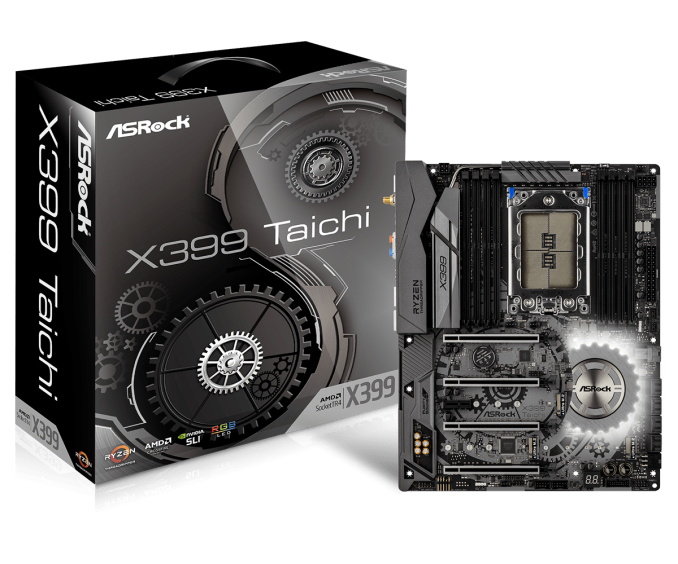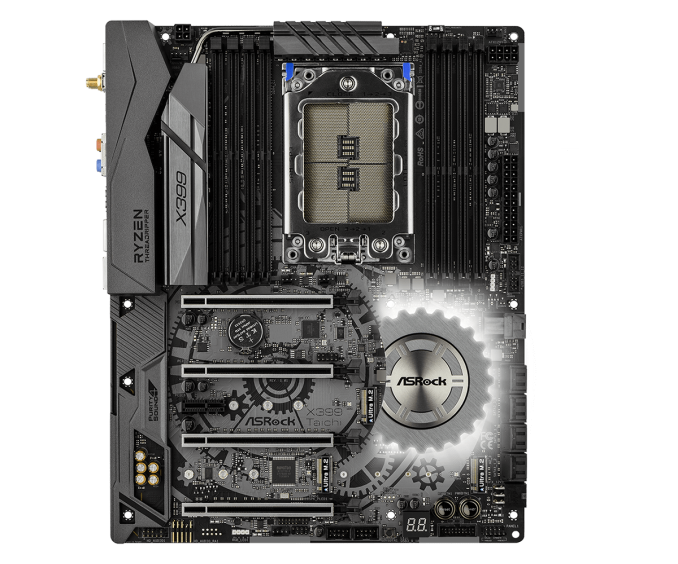An AMD Threadripper X399 Motherboard Overview: A Quick Look at Seven Products
by Ian Cutress & Joe Shields on September 15, 2017 9:00 AM ESTASRock X399 Taichi
The X399 Taichi is configured at a lower point down the ASRock product stack from the Professional Gaming. The Taichi forgoes 10 Gigabit Ethernet, and instead of the Creative Sound Blaster Cinema 3 suite for audio the Taichi uses Purity Sound 4 and a Realtek ALC1220 Codec.
Normally we associate ASRock’s Taichi models with black and white, but this time ASRock has made the board white and grey and drawing attention to the fact that the LEDs can be white if needed. So this means the X399 Taichi has a black PCB with gray accents in the shape of cogs on the PCB area between the PCIe slots and around the chipset heatsink. The DRAM slots are black, while the dual heatsinks for the VRM stretch around to the rear IO via a heatpipe are gray. Much like the Professional Gaming, the only integrated RGB LEDs are under the chipset heatsink, although there are two RGB LED headers for connecting additional RGB strips, all of which can all be controlled by the RGB LED application bundled with the board.
Just like the Professional Gaming, the Taichi supports up to 4-Way SLI and 4-Way Crossfire, with the PCIe slots reinforced using ASRock’s ‘Steel Slot’ protection. From top to bottom, the PCIe slots offer x16/x8/x16/x8 connectivity, taking 48 of the 60 PCIe lanes from the chipset. The final twelve are dedicated to storage with three onboard PCIe 3.0 x4 M.2 slots, one of which is switched with a U.2 connector. Other storage connectivity comes from eight SATA ports, supporting RAID 0/1/10.
The X399 Taichi uses two Intel I211AT gigabit Ethernet controllers, as well as an Intel 3168 1x1 802.11ac WiFi module.
In an almost copy-paste of the Pro Gaming, the Taichi uses the same digital 11 phase IR solution, along with the same EPS placement on the board. USB connectivity on the Taichi is the same as well, with three USB 3.1 (10 Gbps) Type-A ports on the rear panel, one USB 3.1 (5 Gbps) Type-C port on the rear panel, two onboard USB 3.1 (5 Gbps) headers for the front panel, and two USB 2.0 headers as well.
| ASRock X399 Taichi | |
| Warranty Period | 3 Years |
| Product Page | Link |
| Price | $339.99 |
| Size | ATX |
| CPU Interface | TR4 |
| Chipset | AMD X399 |
| Memory Slots (DDR4) | Eight DDR4 Slots, up to 3600 MT/s Supporting 128GB Quad Channel |
| Network Connectivity | 2 x Intel I211AT GbE |
| Wireless Network | 802.11 ab/g/n/ac Dual-Band (2.4/5 GHz) Bluetooth 4.2 |
| Onboard Audio | Realtek ALC1220 |
| PCIe Slots | 4 x PCIe 3.0 (x16/x8/x16/x8) from CPU 1 x PCIe 2.0 x1 from Chipset |
| Onboard SATA | 8x Supporting RAID 0/1/5/10 |
| Onboard SATA Express | None |
| Onboard M.2 | 3 x PCIe 3.0 x4 - NVMe or SATA |
| Onboard U.2 | 1 x PCIe 3.0 x4 (disables M2_1 when in use) |
| USB 3.1 | 1 x Type-A, 1 x Type-C (Rear Panel) |
| USB 3.0 | 8 x Rear Panel, 4x via internal headers |
| USB 2.0 | 4 x via internal headers |
| Power Connectors | 1 x 24-pin ATX 1 x 8-pin CPU |
| Fan Headers | 1 x CPU (4-pin) 1 x CPU Opt/Water Pump (4-pin) 2 x Chassis (4-pin) 1 x Chassis Opt/Water Pump (4-pin) |
| IO Panel | 2 x Antenna Ports 1 x PS/2 Mouse/Keyboard Port 1 x Optical SPDIF Out Port 1 x USB 3.1 Type-A Port 1 x USB 3.1 Type-C Port 8 x USB 3.0 Ports 4 x USB 3.0 Ports 2 x RJ-45 LAN Ports w/ LED 1 x BIOS Flashback Switch HD Audio Jacks |















99 Comments
View All Comments
CityBlue - Saturday, September 16, 2017 - link
The noisy 40mm fan is a major deal breaker for me - what are ASUS thinking by including this? They should add better passive cooling - I don't need the stupid little fan failing or becoming less effective in 2-3 years, leading to random instability.Real shame as my last two motherboards (Intel and AMD) have been from ASUS and I've been really happy, but for Threadripper they're off my list until they design a passively cooled motherboard.
mapesdhs - Tuesday, September 19, 2017 - link
Must admit I quite the look of that Gigabyte Designare-EX, and likewise until now almost all my boards have been ASUS (except for some X58/P55 boards from Asrock, though I have three top-end ASUS P55 boards aswell).I note the absence of EVGA. Have they basically quit the mbd business?
Threska - Sunday, September 17, 2017 - link
Nice, but one deficiency that's carried through a lot of boards is dealing with headers. The writing's tiny. The locations are difficult even if the boards not populated. Documentation a lot of times isn't clear. The one good thing is that it's usually done only once (build time).prisonerX - Monday, September 18, 2017 - link
You need the motherboard equivalent of a large print book.Threska - Monday, September 18, 2017 - link
Endoscope actually, but not everyone has those.msroadkill612 - Saturday, September 23, 2017 - link
A large print, e-atx atx.peevee - Monday, September 18, 2017 - link
Sorry, but $350-550 for a dumb, single-socket, homebound motherboard is insane.satai - Monday, September 18, 2017 - link
What don't you get on "HEDT"?You probably don't need it/don't have money for it. Some people do.
mapesdhs - Tuesday, September 19, 2017 - link
He's either trolling or just ignorant. I know a guy who has MS, got a PhD in a relevant discipline and now does research on his own condition. A TR board would be ideal for the work he does, using lots of GPUs for compute, etc. (biomedical apps) Then there are those who game but also want to stream and encode, and of course solo professionals who can't afford dual-socket XEONs or Opteron-type boards. And plenty of people work at home, so the location of a system at home means nothing. I have a 36-CPU supercomputer in my garage. :Dwiyosaya - Monday, September 18, 2017 - link
The MSI Pro Carbon looks like it has 4 PCI-e 3.0 X16 slots from the diagram in the article. I have to wonder whether those slots are actually electrically X16 slots or some other configuration. I have not been able to find any information on their site or in this article that gives the electrical configuration of those slots. Anyone know for sure?